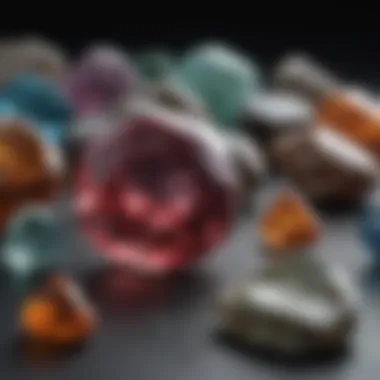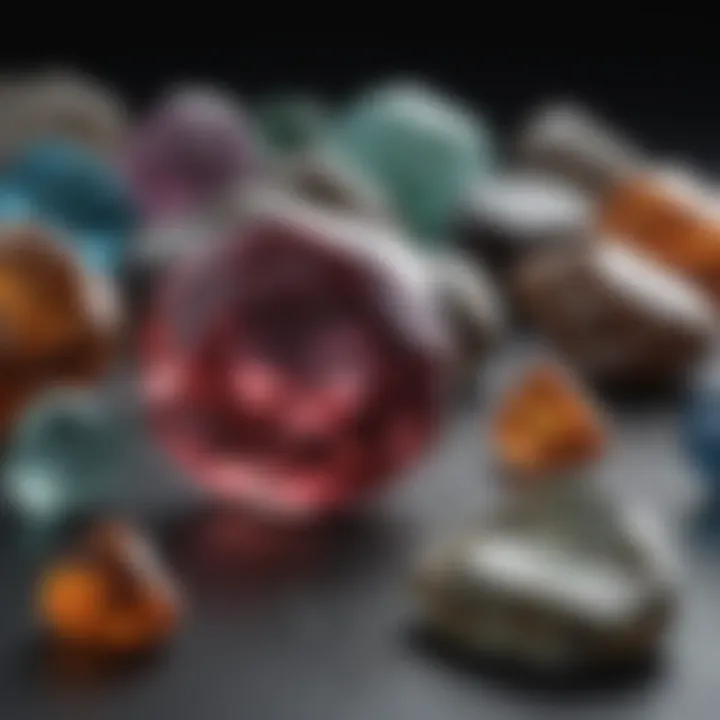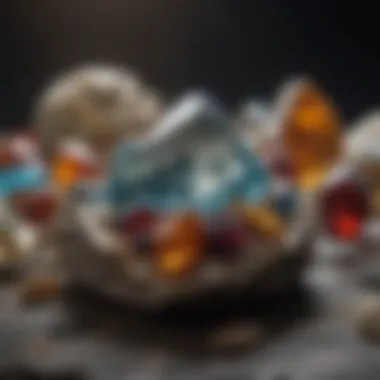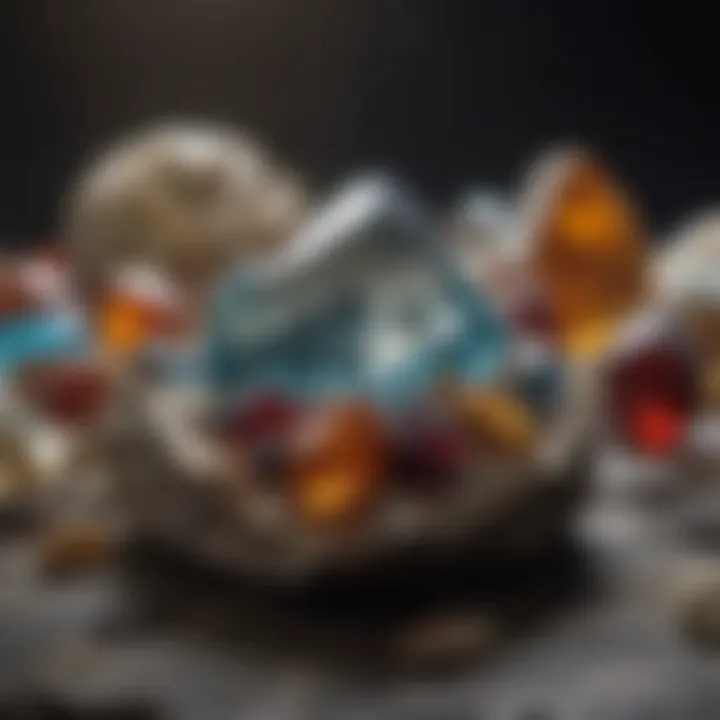Mastering Gemstone Identification: An In-Depth Guide


Intro
Gemstones have captivated human imagination for centuries. From the moment they are formed deep within the Earth’s crust to their unveiling in the hands of skilled artisans, these natural wonders carry stories that transcend time and space. This guide seeks to bridge the gap between mere admiration and informed appreciation of these treasures of nature. It offers collectors and enthusiasts a roadmap for identifying different gemstones, their classification, and understanding their historical and cultural significance.
Why is Identification Important?
When it comes to gemstones, identifying the right stone isn’t just about aesthetics; it often affects value. Knowing how to accurately classify stones, whether it’s for personal collections or potential sales, can mean the difference between acquiring a genuine treasure and being duped by less valuable imitations. This guide will arm you with the tools, techniques, and historical context needed to navigate the fascinating world of gemstones.
History and Origins
Overview of Collectibles, Rocks, and Fossils
The collection of gemstones has roots that date back to ancient civilizations. They were often not just pretty trinkets but were thought to possess unique powers. The ancient Egyptians adorned themselves with lapis lazuli and turquoise, believing they could invoke protection and wisdom. Meanwhile, native tribes in North America often used stones like jade for ritualistic purposes.
Today, the practice of collecting gemstones has evolved considerably. While enthusiasts still appreciate beauty, many aim to understand the geological and cultural narratives behind each piece. This includes discussing and organizing gemstones by categories such as mineral types, hardness, and even metaphysical properties, creating a rich tapestry of knowledge that adds depth to the collecting experience.
Historical Significance and Cultural Impact
Throughout history, gemstones have played pivotal roles in cultures around the globe. The famed Hope Diamond, notorious for its alleged curse, tells a story of wealth and misfortune, intriguing collectors and mystics alike. In India, gems are deeply woven into the fabric of spirituality and are often connected with astrology. Each gem embodies a planet, influencing destiny and providing guidance to its wearer.
"In every gem, there’s a universe; each facet reveals a story waiting to be told."
The cultural lore surrounding gemstones has an incredible impact on their valuation. Vivid tales of legendary stones, such as the Koh-i-Noor and the Star of Asia, contribute to the perceived worth and desirability of various gems today. Understanding these historical narratives enriches a collector’s experience, creating a personal connection with their collections.
Identification and Classification
Guide to Identifying Rocks and Fossils
Identifying gemstones involves several methods, each varying depending on the stone's properties. Collectors often rely on visual cues, hardness tests, and even chemical properties to differentiate between stones.
- Visual Inspection: The color, luster, and clarity are the first indicators to examine.
- Hardness Test: Using Mohs Scale to assess how well a gemstone can withstand scratches helps gauge its identity.
- Specific Gravity: Weighing a gemstone in air versus water can provide additional insights into its composition.
Common Types and Variations
Gemstones can be categorized broadly into two groups: precious and semi-precious. Each has its unique variations.
- Precious Gemstones: Diamonds, rubies, sapphires, and emeralds are the most sought after, embodying not just beauty but rarity.
- Semi-Precious Gemstones: Stones like amethysts, citrines, and garnets are more widely available but also come with unique characteristics that can be just as enchanting.
Familiarizing oneself with the nuances of these types enhances understanding and appreciation. Each gemstone has distinctive traits that can captivate the collector, producing both personal satisfaction and intellectual curiosity.
In the following sections of this comprehensive guide, we will delve even deeper into tools for assessment, practical techniques, and a detailed chart to serve as a valuable resource for both novice and seasoned collectors.
Understanding Gemstones
Gemstones have long captured the imagination and curiosity of humans. They are not just pretty objects to admire, but hold substantial historical, cultural, and scientific significance. Understanding gemstones is vital for anyone interested in collecting or simply appreciating these natural wonders. This section delves into the core elements about gemstones, focusing on their definition, significance, and the rich history behind them.
Definition and Significance
At its core, a gemstone is a piece of mineral crystal that, when cut and polished, can be used for jewelry or ornamentation. However, the definition expands beyond just the physical properties. Gemstones are imbued with meanings that span different cultures and eras.
Their significance lies in their rarity, beauty, and the emotional ties they can evoke. For instance, a diamond may symbolize enduring love, while an emerald is often associated with rebirth and fertility. This personal connection makes each stone unique.
Many enthusiasts dive into collecting gemstones not only for their beauty but also for their perceived value. The worth of a gemstone can fluctuate drastically based on factors like size, clarity, and origin. This makes understanding gemstones not only interesting but also potentially lucrative, as a well-informed collector may find themselves with valuable pieces in their collection.
Historical Context of Gemstones
The allure of gemstones isn't a modern phenomenon; it stretches back through the annals of history. In ancient times, gemstones were often believed to possess mystical powers and were used in various rituals. Cultures around the world revered them, from the Egyptian Pharaohs who adorned themselves with lapis lazuli, to the indigenous peoples of the Americas using turquoise for spiritual protection.
Understanding this historical context deepens a collector's appreciation of gemstones. It connects the dots between the past and present, revealing how these stones have played vital roles in different societies. Back in the day, a ruby was thought to provide safety in battle, and many still associate it with bravery today.
In contemporary times, gemstones often feature in social media trends, art, and even technological advancements, showing how these ancient elements adapt and thrive in modern culture. Their legacy continues to evolve, making the exploration of their role in history an intriguing journey for any gemstone enthusiast.
"Gemstones are not just Earth’s beauty; they are windows into history and whispers of human experience."
Through this understanding of gemstones, you gain a multi-faceted perspective on their role in our lives, culture, and economy. With that foundation, we can delve deeper into the classification and the criteria needed to identify these enchanting treasures.
Classification of Gemstones
Understanding the classification of gemstones is crucial for anyone serious about rock and fossil collecting. This section not only categorizes gems but also provides context on their significance—be it aesthetic, historical, or monetary. The nuances involved in classification help enthusiasts and collectors discern the quality and value of gemstones. Knowing whether a stone is classified as precious or semi-precious, or identifying its origin can profoundly influence its desirability in the market. Diving into these categories unearths rich stories behind each stone, allowing collectors to appreciate their path from formation to market.
Precious versus Semi-Precious Stones
The distinction between precious and semi-precious stones is not just a matter of terminology. It carries a weight of historical significance and valuation. Precious stones typically include diamonds, rubies, sapphires, and emeralds. They are often revered for their rarity and beauty, drawing buyers and collectors into a realm where value can skyrocket.
Characteristics of Precious Stones:
- Rarity: Precious stones are often rare, which contributes to their higher market prices.
- Durability: They boast a greater hardness, making them ideal for jewelry that withstands daily wear.
- Cultural Significance: Many cultures place immense symbolic value on these stones, often tying them to histories or myths.
On the flip side, semi-precious stones encompass a broad category including amethysts, aquamarines, and garnets. While these gems are often more plentiful and less expensive than their precious counterparts, they still possess unique beauty and character.
Traits of Semi-Precious Stones:
- Variety: The sheer range of color and patterns available in semi-precious stones can be dazzling.
- Affordability: They provide an accessible option for collectors on a budget without sacrificing beauty.
- Utility in Healing: Many semi-precious stones are touted for their metaphysical properties, drawing those interested in alternative healing.
Ultimately, the classification into precious and semi-precious stones serves as a framework—one that provides clarity to both novice and seasoned collectors alike. By understanding these basic classifications, collectors can make informed decisions that align with their personal collecting goals.
Natural, Synthetic, and Imitation Gemstones
The world of gemstones is intricate, further complicated by a spectrum ranging from natural stones to synthetics and imitations. Knowing where a gemstone falls on this spectrum is essential for understanding its market value and authenticity.


Natural Gemstones are those that have formed through geological processes without human intervention. Collectors deeply value these stones due to their genuine origins and often unique attributes that tell a story of Earth’s processes over millennia.
Synthetic Gemstones, however, are crafted in laboratories but possess the same chemical composition and physical properties as their natural counterparts. A classic example is the synthetic ruby, which is created through chemical synthesis. These stones can mimic the appearance of natural stones but often at a fraction of the cost.
- Pros: They can be more affordable and available in larger sizes.
- Cons: Collectors seeking authenticity may shy away due to their manufactured nature.
Lastly, Imitation Gemstones pose as natural stones but lack similar properties. Glass or resin pieces often fall under this classification and can be beautifully crafted but serve entirely different purposes than genuine gemstones. Recognizing the difference is integral in protecting oneself from being blindsided in transactions.
"The secret to appreciating gemstones lies in knowing their origins, characteristics, and the stories they tell."
In summary, understanding these classifications allows collectors not just to identify stones, but to unravel a narrative that connects them to the Earth, human craftsmanship, and even the trivialities of modern markets. By becoming adept at discerning between natural, synthetic, and imitation gemstones, one positions oneself as a knowledgeable participant in both the collection and appreciation of these exquisite natural wonders.
Key Criteria for Identification
Identifying gemstones accurately is a blend of art and science. The meticulous evaluation of several key criteria allows rock and fossil collectors—not to mention gem enthusiasts—to determine the authenticity and quality of these treasures. Thorough understanding of these criteria is essential, as they can influence the value and appeal of the gemstone in question. Each criterion offers a unique angle for assessment, supporting informed decisions and fostering appreciation for the complexities inherent in gemology.
Color and Transparency
Color is perhaps the most striking feature of any gemstone. It captivates the eye and impresses the heart, often being the first aspect noticed. But color is not merely a superficial trait; it is tied intricately to the stone's identity and classification. Gemologists consider three essential elements—hue, tone, and saturation—when evaluating color. For instance, a sapphire may traditionally convey a deep blue hue, yet variations in tone could range from navy to powder blue and significantly affect its desirability.
Transparency further enriches this perspective. Gemstones can be categorized as transparent, translucent, or opaque, each signifying how light interacts with the material. Transparent stones transmit light clearly and effortlessly, while opaque stones obscure it entirely. A classic example lies with jade: when it's transparent, it tends to fetch higher prices compared to its opaque counterparts.
Hardness and Durability
The hardness of a gemstone is measured using the Mohs scale, which ranks materials from 1 (talc) to 10 (diamond). This is crucial because harder stones are generally more resilient to scratches and daily wear, making them favorable for jewelry. For instance, sapphires and rubies, both rated at 9, stand as well-rounded choices for rings and pendants, showcasing both their beauty and durability.
Durability encompasses more than just hardness; it includes resistance to fractures and changes due to environmental factors. For example, opals, despite their enjoyable aesthetic, have a lower durability factor and are often relegated to less frequently worn pieces. This consideration is particularly vital for collectors who appreciate gemstones as long-term investments.
Specific Gravity and Luster
Specific gravity—a measure of density relative to water—can be a revealing characteristic when identifying gemstones. For example, a stone that feels heavier in hand might signify a denser mineral composition, which can help distinguish it from similar-looking stones. This detail can be particularly useful when differentiating between quartz and topaz, as their visual appeal may easily mislead the uninformed.
Luster describes the way a gemstone's surface interacts with light. It can be categorized into several types such as glassy, dull, or metallic. For instance, diamonds boast an exceptional brilliance and fiery luster that sets them apart from other stones, making the initial moment of gaze captivating. A gem's luster can say a lot about its quality under examination—watch carefully to avoid mistakes.
Cleavage and Fracture
Cleavage refers to the way a gemstone can break along specific planes, reflecting its internal structure. Not all stones exhibit this characteristic; some, like quartz, may break unevenly instead. Knowing these traits helps collectors anticipate how a stone might perform under pressure.
In contrast, fractures occur when the structure breaks in an unpredictable manner. Examining a gem's cleavage and fracture can reveal critical insights about its quality and potential vulnerability to damage. For example, emeralds are known for their inherent fractures—termed 'jardin'—which are common yet can affect the stone's appeal and price.
"Mastering the key criteria for gemstone identification is an investment in your knowledge as a collector. These elements foster a deeper appreciation for nature's artwork and the science behind each unique specimen."
Mastering these criteria fosters a connection with the gemstones themselves, enriching the experience of both collecting and appreciating them. Each of these components weaves together the fascinating narrative of what defines a gemstone—even in the eyes of a discerning collector.
The Gemstone Identification Chart
A gemstone identification chart is an invaluable tool for both collectors and enthusiasts. It acts as a comprehensive reference guide that demystifies the process of identifying various gemstones. With so many stones to explore, knowing where to look and what to look for can make all the difference in making an informed choice in your collection or purchase.
Unique to each gemstone, the chart encompasses critical characteristics such as color, hardness, and specific gravity. Having this information at your fingertips not only enhances your understanding of these precious stones but also helps in accurately distinguishing one from another. The nuances of gemstone identification can mean the difference between authentic and imitation stones, hence the chart's significance.
"A well-constructed gemstone identification chart combines art and science, elevating the collector's experience while grounding it in factual knowledge."
Overview of the Chart's Utility
The utility of the gemstone identification chart cannot be overstated. First and foremost, it simplifies the identification process, breaking down complex information into manageable segments. For instance, when you pick up an unidentified stone, the chart allows you to quickly reference its possible properties, making it easier to ascertain its identity.
Additionally, the chart serves as a teaching tool. If you're a novice, it provides a structured way to familiarize yourself with the basics of different gemstones. A knowledgeable examiner can easily reference the chart during an assessment, ensuring they do not miss critical details. This efficiency is beneficial in situations like trade shows, where quick identification can lead to potential investment opportunities.
Data Format and Structure
A well-organized gemstone identification chart should feature a clean and logical format. This code block illustrates how data about gemstones can be structured to enhance clarity and usability:
In this table, each characteristic required for proper identification is listed alongside the gemstone name. Organizing the data this way makes it instantly accessible, thus ensuring that anyone from the curious novice to the seasoned collector can quickly deduce key information and make informed decisions.
The information contained within the chart should also be regularly updated. As new gemstone treatments and synthetics emerge, it is essential to include these updates in order to keep the information current. By refining the chart and its structures, collectors and enthusiasts can ensure a high degree of accuracy in their identification endeavors.
Popular Gemstones and Their Properties
Understanding popular gemstones and their distinct properties holds significant value for collectors and enthusiasts. Within the world of gemstones, various stones symbolize different traits, histories, and aesthetic merits. This section serves as a roadmap to guide individuals through the specific characteristics that make each of these stones unique. Knowledge of these gemstones is more than just an academic exercise, as it can positively impact purchasing decisions, conservation efforts, and overall appreciation for the art of gemstones.
Diamonds
Color Variations
Color plays a crucial role in distinguishing diamonds. While many people associate diamonds solely with clarity and brilliance, the reality is that they come in a rich palette of colors, including blue, pink, yellow, and even green. These colors arise from different environmental influences during the stone's formation, impacting their rarity and value. The unique feature of color variations is that a pink diamond, for instance, can be far more valuable than its colorless counterpart. However, potential buyers must consider that color intensity can vary widely. Thus, understanding these nuances is vital; you wouldn’t want to be caught short on information!
Types of Diamonds
Diamonds can be categorized into various types based on their formation conditions and the characteristics they exhibit. The most popular types include natural, synthetic (lab-grown), and fancy color diamonds. Each type carries its own tale and unique value proposition. Natural diamonds often fetch higher prices due to their perceived rarity. Synthetic diamonds may offer a more affordable option, making them appealing for those on a budget. Understanding these distinctions helps individuals make informed choices in a market teeming with options.
Value Assessment
Assessing the value of diamonds requires a keen understanding of the 4Cs: Cut, Color, Clarity, and Carat weight. Often, collectors overlook the cut, but its impact on a diamond's appearance cannot be overstated. Additionally, trends in the diamond market shift quickly; what was once in high demand may fall out of favor much to the dismay of some collectors. By being aware of these metrics and ongoing trends, gemstone enthusiasts can navigate the diamond market more effectively.
Emeralds
Origin and Quality


Emeralds boast a captivating history, particularly originating from Colombia, Zambia, and Brazil. The origin influences the stone's quality and coloration significantly. Colombian emeralds, for instance, are renowned for their rich green hues and fewer inclusions than those from other sources. Detecting these quality markers can mean the difference between a treasured piece or a mere imitation. Therefore, understanding where an emerald originates is crucial for any serious collector.
Symbolism
Emeralds embody a rich spectrum of symbolism, often associated with rebirth, love, and hope. Their lush green color links them to nature, evoking feelings of harmony and balance. Understanding the symbolic weight of emeralds adds another layer to a collector's appreciation. While a beauty to the eye, the emotional significance attached to emeralds makes them all the more precious—both visually and sentimentally.
Identification Marks
Identification marks on emeralds can tell collectors much about the stone. Inclusions, such as patterns unique to certain varieties, can help authenticate an emerald. Additionally, tools like magnifying glasses can reveal whether the stone is treated or untreated. Opting for untreated stones often results in a valuable return on investment. Thus, knowing these identification marks is essential for savvy collectors.
Sapphires
Varieties of Sapphires
Sapphires are not merely blue; they come in an array of colors. From yellow to pink—known as padparadscha—each variety possesses its own distinctive allure. Color diversity reflects the specific trace elements within the stone during formation. Collectors benefit from understanding these variants, as personal preferences can guide purchasing decisions effectively, ensuring they find the right piece for their collection.
Synthetic vs Natural
The debate between synthetic and natural sapphires often centers around ethical sourcing and cost. Synthetic sapphires—lab-created—are less expensive and more available. However, identifying whether a sapphire is natural can elevate its status significantly in a collection. Investors especially care about the authenticity of their stones, as natural sapphires typically hold more enduring value compared to their synthetic brethren.
Market Trends
The market for sapphires has seen fluctuations tied to fashion and trends over the years. Notably, the rising popularity of non-blue sapphires has shifted attention from classic blue stones. Monitoring market trends allows collectors to anticipate shifts and adjust their strategies accordingly. Awareness of prevailing fashions can help enhance investment returns, ensuring they buy when prices are favorable.
Rubies
Color Characteristics
Rubies are often defined by their stunning red color, which stems from chromium content during formation. The most sought-after shade is known as "pigeon blood" red. The vibrancy of rubies significantly affects their value, with a deeper hue translating into a higher price. Passion for collecting rubies often revolves around understanding how these colors resonate with individuals, culminating in personal and financial investment.
Extraction Sites
Primary extraction sites for rubies include Myanmar, Thailand, and Mozambique. Each location yields unique characteristics that influence the stone's appearance and value. Collectors must appreciate the geography behind their stones, as it gives insight into their rarity. Understanding extraction sites can also affect resale values, guiding buyers toward those most likely to appreciate over time.
Price Indicators
There are further metrics to watch when assessing ruby prices. The clarity, carat, and color saturation all play vital roles in valuation. Prices can also fluctuate based on market demand, historical sales, and gemstone trade regulations. Being aware of these price indicators can help collectors spot good deals and avoid overpaying.
Amethysts
Historical Use
Throughout history, amethysts represented luxury and power, favored by royals and religious figures alike. The name itself comes from the Greek "amethystos", meaning "not intoxicated." Emperors and monarchs would wear amethysts to symbolize authority. This historical association enriches the narrative surrounding amethysts, adding depth for modern collectors who appreciate context just as much as the stone itself.
Geological Formation
Amethysts are a quartz variant, with their beautiful purple color resulting from iron impurities during formation. They typically form in geodes, creating the dazzling displays often found in jewelry today. Understanding their geological formation gives collectors insight into their value and unique features, further enhancing the hobby’s allure.
Current Applications
In contemporary settings, amethysts find homes in both jewelry and alternative healing practices. Their popularity continues to hold fast, from statement pieces in high-end fashion to wellness ascribed properties. Understanding these applications can guide collectors in diversifying their collections, appealing to both aesthetic preferences and personal philosophies that influence modern collecting.
Tools for Gemstone Identification
Identifying gemstones with precision is not something one can pull off with just a keen eye and ample enthusiasm. The various tools available play a crucial role in aiding collectors and enthusiasts distinguish between gems with similar appearances. Specialized equipment enhances the process of identification, offering accuracy and saving time. Employing proper tools allows not just for differentiation among stones, but also provides insights into their quality and authenticity. In the world of gemstones, investing in the right tools is like choosing a well-crafted chisel for sculpting a masterpiece; both require care, knowledge, and an understanding of the material.
Magnification Instruments
Magnification is fundamental when it comes to gemstone identification. Instruments like jewelers' loupes and microscopes reveal intricate details invisible to the naked eye. A 10x jeweler's loupe is particularly favored among gemologists due to its portability and ease of use. By bringing the gemstone closer, collectors can scrutinize imperfections, inclusions, and surface features—vital for determining authenticity. For instance, those little specks within a stone might whisper clues about its origins.
Using these instruments, one can observe:
- Inclusions - Internal features that provide evidence about the stone’s natural formation.
- Bubbles - Indicative of synthetic gems, these can often be seen in glass imitations.
- Surface Scratch - Marks or abrasions give insight into how a stone has been treated.
Testing Kits and Reagents
Another set of invaluable tools comes in the form of testing kits and reagents. These kits present a hands-on approach to gemstone identification, employing simple chemical tests to determine a stone's true nature. For example, a commonly used acid test can effectively differentiate between natural stones like calcite and counterfeit materials. Testing kits generally include:
- Polariscope - Helps identify pleochroism—a feature of certain gems that change color when viewed from different angles.
- Acid Test Solutions - Used to react with certain minerals displaying distinctive colors or bubbling effects.
- Hardness Testing Kits - A set of reference materials, often ranging from talc to diamond, which allows one to test the hardness of the gem.
Incorporating these tools means relying on scientific methods to ensure authenticity. For the collector eager to authenticate a gemstone, these tests are indispensable.
Spectroscopes and Other Advanced Equipment
When moving beyond basic identification, advanced tools like spectroscopes come into play. These devices analyze a gemstone's light spectrum and can help determine its elements based on how light interacts with the material. The spectroscope can unveil the fingerprint of a gemstone, differentiating one variety from another, even when they look awfully similar.
Other advanced equipment might also include:
- Refractometers - Measure the refractive index, which can pinpoint the stone’s identity.
- Gemstone Photometers - Reveal unique color characteristics that arise from specific elements within the stone.
- Gem Quick Test Kits - Offer a battery of quick assessments like weight, density, and other physical properties.
Gemstone identification tools are the unsung heroes of the collector's journey. With the right equipment, understanding the depth of what one holds becomes a rewarding experience.
Techniques for Assessing Gemstones
Assessing gemstones accurately is essential not only for determined collectors but also for anyone who appreciates these natural wonders. Understanding various methods to evaluate gemstones can significantly aid in distinguishing between different types. Each technique has its own unique strengths and considerations that can help one arrive at a correct identification.
Visual Inspection Methods
Visual inspection might sound simple, yet it’s surprisingly effective in assessing the quality of a gemstone. With just your eyes, you can often spot crucial characteristics such as color, clarity, and brilliance. Examine the stone under natural light; it can help reveal the full spectrum of colors present in the gem.


Some pointers for effective visual inspection:
- Look for inclusions or blemishes; these can indicate the authenticity of a natural stone.
- Assess the symmetry of the cut and polish of the gem. An uneven polish or poor cut can affect value.
- Pay attention to the overall color saturation. Colors that are vibrant and evenly distributed are more desirable.
Ultimately, honing your visual skills is critical, as it lays a solid foundation for deeper assessments.
Comparative and Contrast Analysis
One step more advanced than just looking is the comparative and contrast analysis. This technique involves examining a subject gemstone alongside known examples. It’s like holding apples to apples, so to speak. This method provides a solid reference point when determining a gem’s identity.
In practicing comparative analysis, you need to:
- Gather several gemstones that you know are either natural or imitation.
- Compare them side by side with the unknown stone, paying close attention to their attributes.
- Make notes on discrepancies, which could help identify whether your gem is genuine or merely a good-looking repro.
This analytical approach adds a layer of rigor to your evaluation, making it much easier to determine essential qualities such as brilliance or imperfections.
Utilizing a Gemological Laboratory
For those situations where your own techniques simply aren’t enough, turning to a gemological laboratory is a prudent choice. These labs house experts and advanced equipment that can evaluate gemstones far beyond the capability of the average collector.
Services typically offered by gemological labs include:
- Detailed reports that cover origin, enhancements, and grading standards.
- Advanced techniques like spectroscopy and refractive index testing that exceed what most enthusiasts can perform.
- Certifications that can significantly aid in resale or insurance evaluations.
Utilizing such a laboratory is about ensuring confidence in your assessments and understanding intricate details that play pivotal roles in valuation. If you are serious about your collection, investing in lab services is one way to go above and beyond, securing both knowledge and accuracy.
The path to gemstone expertise often leads through practical assessment techniques and reputable laboratories.
Caring for Gemstones
Caring for gemstones is more than just a set of chores; it's a crucial element in preserving the beauty and integrity of your collection. Whether you're a casual collector or a seasoned expert, understanding how to properly care for these exquisite stones enhances their lifespan and maintains their value. Mistreating a gemstone can lead to scratches, dullness, and even irreversible damage. By investing time in proper care, you'll ensure that your collection remains vibrant and worthy of admiration.
Cleaning and Maintenance Tips
Keeping your gemstones clean requires a blend of common sense and specific techniques. Here are some tips to keep in mind:
- Use mild soap and water: For most stones, a gentle mix of warm water and mild dish soap does wonders. Avoid harsh chemicals, as they can tarnish or damage the surface.
- Soft cloths are your best friend: Always use a soft, lint-free cloth to wipe your gemstones after wearing them. This removes oils and dirt that accumulate through contact with skin.
- Avoid ultrasonic cleaners: While these devices can be effective for some items, gemstones like pearls and opals may absorb water or suffer damage when exposed to ultrasonic waves.
- Make a schedule: Regularly inspecting and cleaning your stones helps catch any potential issues early. Depending on how often the stones are worn, a monthly check-up could be ideal.
Proper maintenance ensures that your gemstones reflect their true quality and allure. Taking care of them is like fine-tuning a musical instrument; every little detail matters.
Environmental Factors to Consider
The environment in which gemstones are stored is just as important as how they’re cleaned. Factors like humidity and exposure to sunlight can significantly affect their condition.
- Temperature Fluctuations: Excessively high or low temperatures can cause stones to crack or lose their color. Store them in a climate-controlled area where the temperature remains stable.
- Humidity Levels: Keeping gems in overly humid conditions can lead to mold on softer stones, while dryness can crack them. Using silica gel packets in storage allows for humidity control.
- Light Exposure: Some stones, such as amethyst and topaz, can fade when exposed to prolonged sunlight. Store them in dark places or in cloth pouches to limit light exposure.
Maintaining the proper environmental conditions protects the integrity of your gemstones, ensuring that their beauty endures throughout the years.
By considering both cleaning practices and environmental influences, you can elevate the care you give to your gemstones. Understanding these facets not only preserves their physical appeal but also honors their rich history and value, which is essential for any dedicated collector.
The Role of Gemstones in Collecting
When it comes to collecting, gemstones shine not just for their aesthetic beauty but also for the diverse values and stories they hold. Many enthusiasts see their collection as more than mere trinkets; they consider it an art form, a slice of history, and often, a financial investment. Collecting gemstones taps into various human desires: the thrill of discovery, the pride in ownership, and sometimes, the ambition of profit.
The significance of gemstones in collecting cannot be overstated. Investing in them is often viewed through multiple lenses—emotional attachment, financial yield, and cultural appreciation all play a role. With each stone comes a unique narrative, whether it be the legend of a particular mine, the journey of the gem itself, or the lore surrounding its mystical properties.
"A gemstone is not just a simple object; it embodies the earth's histories, human cultures, and the artistry of craftsmanship."
Investment Potential
Investing in gemstones has its own set of intricacies and allure. Unlike more conventional investment strategies, such as stocks or real estate, gemstones offer tangible value that can go beyond financial metrics. Some key points to consider when thinking about gemstones as an investment include:
- Market Demand: The value of gemstones often fluctuates with market trends. It's not uncommon for certain stones to appreciate significantly over time, influenced by factors like rarity and demand.
- Grading and Quality: Evaluating a gemstone's worth often hinges on its quality—color, cut, clarity, and carat all play crucial roles. Understanding these characteristics is essential for any collector looking to maximize their investment.
- Diversification: Just like any other investment portfolio, a varied collection of gemstones can mitigate risks. This can involve acquiring stones of different types, origins, and market value.
- Long-Term Stability: Historically, high-quality gemstones, particularly those categorized as precious, tend to withstand market turbulence. They can serve as a hedge against economic uncertainties.
For many collectors, the idea of investing in gemstones also entails considering future generations. Passing on a carefully curated collection can embed a sense of legacy and familial history that transcends mere monetary value.
Community and Expert Resources
Engaging with a community or tapping into expert resources can greatly enhance one’s knowledge and experience in gemstone collecting. Here are some ways to connect and benefit:
- Forums and Online Communities: Websites like Reddit have vibrant communities discussing everything from identification techniques to valuation strategies. Here, collectors can seek advice or share their experiences with like-minded individuals.
- Social Media: Platforms such as Facebook host numerous groups and pages dedicated to gemstone enthusiasts. Joining these groups provides access to resources, upcoming events, or even resale opportunities from fellow collectors.
- Workshops and Seminars: Attending local or virtual events featuring experts from the gemology field can provide hands-on experience. Learning about the latest techniques in gemstone evaluation, or even how to care for your collection, can set a collector apart.
- Books and Journals: There’s a wealth of literature out there. Engaging with scholarly articles or comprehensive guides on gemology can systematically enhance one’s knowledge base.
By actively participating in these communities and utilizing expert advice, collectors not only increase their understanding but also build connections that enrich their collecting journey.
In summary, gemstones hold a respected place in the world of collecting. From monetary appreciation to community engagement, they offer numerous pathways to explore. As both an art form and viable investment, the role of gemstones in collecting extends beyond individual stones, weaving a rich tapestry of history, emotion, and opportunity.
Future Trends in Gemstone Identification
As the world of gemstones continues to flourish with both old and new enthusiasts, it becomes paramount to stay ahead of the curve when it comes to identifying these captivating minerals. Future trends in gemstone identification are not merely an afterthought; they encapsulate the evolving dynamics of technology and community engagements that elevate the entire experience for collectors. This segment specifically looks at how advancements in technology and the rise of online platforms are shaping the way enthusiasts and experts alike interact with the world of gemstones.
Technological Advances
The importance of technology in gemstone identification can’t be overstated. Modern innovations have transformed the methods with which gemologists and collectors assess gemstones. The introduction of advanced instruments—like digital microscopes and portable spectrometers—has democratized access to precise identification tools. Having the capability to analyze a stone's characteristics down to molecular levels has taken the guesswork out of identifying gems. The benefits include:
- Increased Accuracy: Instruments now can differentiate between similar-looking varieties with remarkable precision.
- Portability: Compact tools make it easier for collectors to take equipment to gem shows, fairs, or field trips.
- Enhanced Learning: Online tutorials and apps guide users through the identification process, making traditional techniques more accessible.
From artificial intelligence analyzing spectral data to mobile applications that provide instant information about gemstones, collectors can now simplify and enrich their identification processes.
"Without technology, our understanding of gemstones would be stuck in the past, missing valuable insights that can now be easily obtained."
Social Media and Online Communities
The digital revolution grants gem enthusiasts a voice like never before. Social media platforms like Facebook, Reddit, and Instagram have created vibrant online communities dedicated to sharing knowledge, experiences, and discoveries. These spaces foster collaboration, where both novices and experienced collectors can ask questions, share findings, or seek advice. The significant aspects of these communities include:
- Networking Opportunities: You aren’t just connecting with friends; access to a worldwide network of gem lovers expands learning and sharing potential.
- Real-Time Information Exchange: Social media facilitates immediate updates on trends, events, and new identification techniques that can significantly impact collectors.
- Educational Resources: Many groups and forums dedicate themselves to sharing articles, videos, and tips that demystify the identification process.
As the landscape of gem collecting shifts with these online innovations, enthusiasts are encouraged to engage actively within these communities. The collective knowledge acquired through shared experiences drastically enhances the understanding of gemstone properties, leading to confident and informed decisions.



